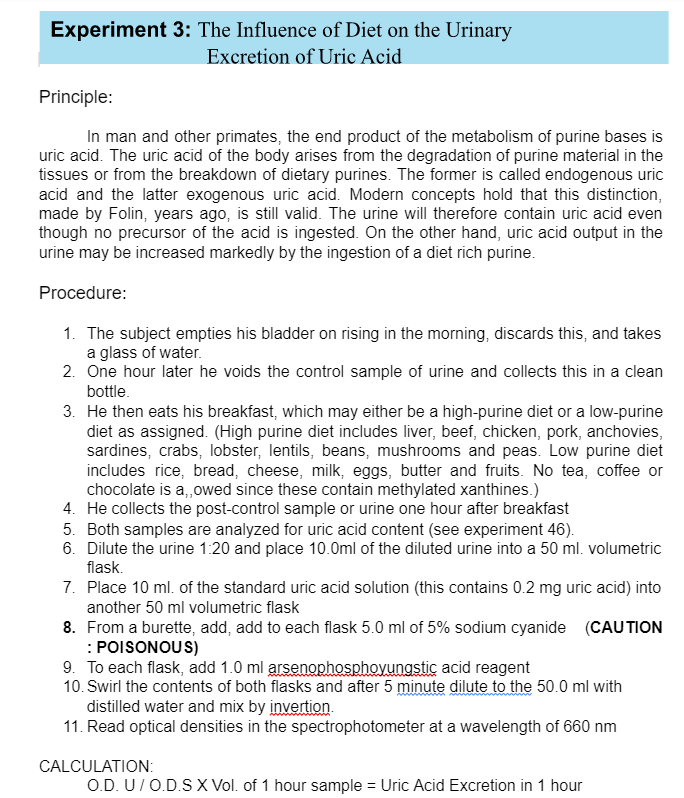Answered step by step
Verified Expert Solution
Question
1 Approved Answer
1. Assuming that the subject are normal and assuming further that they followed their assigned diets to the letter, what conclusion could be drawn from

1. Assuming that the subject are normal and assuming further that they followed their assigned diets to the letter, what conclusion could be drawn from the experiments?
Experiment 3: The Influence of Diet on the Urinary Excretion of Uric Acid Principle: In man and other primates, the end product of the metabolism of purine bases is uric acid. The uric acid of the body arises from the degradation of purine material in the tissues or from the breakdown of dietary purines. The former is called endogenous uric acid and the latter exogenous uric acid. Modern concepts hold that this distinction, made by Folin, years ago, is still valid. The urine will therefore contain uric acid even though no precursor of the acid is ingested. On the other hand, uric acid output in the urine may be increased markedly by the ingestion of a diet rich purine. Procedure: 1. The subject empties his bladder on rising in the morning, discards this, and takes a glass of water. 2. One hour later he voids the control sample of urine and collects this in a clean bottle. 3. He then eats his breakfast, which may either be a high-purine diet or a low-purine diet as assigned. (High purine diet includes liver, beef, chicken, pork, anchovies, sardines, crabs, lobster, lentils, beans, mushrooms and peas. Low purine diet includes rice, bread, cheese, milk, eggs, butter and fruits. No tea, coffee or chocolate is an, owed since these contain methylated xanthines.) 4. He collects the post-control sample or urine one hour after breakfast 5. Both samples are analyzed for uric acid content (see experiment 46). 6. Dilute the urine 1:20 and place 10.0ml of the diluted urine into a 50ml. volumetric flask. 7. Place 10ml. of the standard uric acid solution (this contains 0.2mg uric acid) into another 50ml volumetric flask 8. From a burette, add, add to each flask 5.0ml of 5% sodium cyanide (CAUTION : POISONOUS) 9. To each flask, add 1.0ml arsenophosphoyungstic acid reagent 10. Swirl the contents of both flasks and after 5 minute dilute to the 50.0ml with distilled water and mix by invertion. 11. Read optical densities in the spectrophotometer at a wavelength of 660nm CALCULATION: O.D. U / O.D.S X Vol. of 1 hour sample = Uric Acid Excretion in 1 hourStep by Step Solution
There are 3 Steps involved in it
Step: 1

Get Instant Access to Expert-Tailored Solutions
See step-by-step solutions with expert insights and AI powered tools for academic success
Step: 2

Step: 3

Ace Your Homework with AI
Get the answers you need in no time with our AI-driven, step-by-step assistance
Get Started


